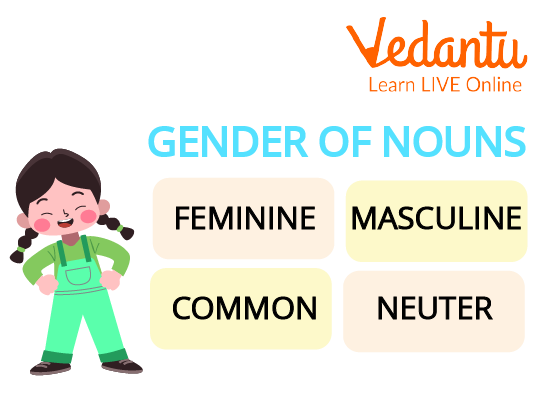Class 1 English Grammar: Understanding Gender (2025-26)
FAQs on Class 1 English Grammar: Understanding Gender (2025-26)
1. How do you solve questions on gender in the NCERT Class 1 English textbook?
To solve questions on gender for Class 1, you should follow a simple method. First, identify if the noun (person or animal) is a male or a female.
- Words for males are called Masculine Gender (e.g., boy, man, king, father).
- Words for females are called Feminine Gender (e.g., girl, woman, queen, mother).
2. What are some common masculine and feminine gender pairs a Class 1 student should know for NCERT exercises?
The NCERT solutions for Class 1 English often focus on common gender pairs to build a strong foundation. Students should practice matching these words:
- Boy - Girl
- Man - Woman
- Father - Mother
- Brother - Sister
- King - Queen
- Uncle - Aunt
- Grandfather - Grandmother
3. How do you correctly use 'He' and 'She' when solving sentence-based questions on gender?
Using 'He' and 'She' correctly is a key part of the NCERT solutions for this topic. The rule is simple:
- Use 'He' when talking about one boy, man, or any male person/animal (masculine gender). For example, "This is Rohan. He is a good boy."
- Use 'She' when talking about one girl, woman, or any female person/animal (feminine gender). For example, "This is Priya. She has a doll."
4. Why is learning about masculine and feminine gender important for a Class 1 student?
Understanding gender is a fundamental step in learning English grammar. It helps a Class 1 student in two main ways:
- Correct Sentence Formation: It teaches them to use the correct pronouns like 'he' and 'she', which makes their sentences grammatically accurate.
- Vocabulary Building: It helps them learn pairs of words (like king-queen, father-mother), which expands their vocabulary and understanding of relationships.
5. Besides people, do animals also have masculine and feminine gender words in Class 1 English?
Yes, the concept of gender in the Class 1 NCERT syllabus also applies to animals. Learning these helps in solving a wider range of questions. Some simple examples you might find in your textbook exercises are:
- Masculine: Lion, Tiger, Rooster
- Feminine: Lioness, Tigress, Hen
6. How do the NCERT Solutions for Class 1 help if I get confused between a boy's name and a girl's name?
The NCERT Solutions for Class 1 English (2025-26) are designed to be very clear. For gender exercises, they use very common and easily recognisable names. For instance, names like Rahul, Amit, and Raj are used for the masculine gender, while names like Priya, Sita, and Rina are used for the feminine gender. The solutions provide clear examples, so you can practise and learn to identify them easily.
7. Are there any words for things that are not 'he' or 'she' in English grammar for Class 1?
That's an excellent question! While the Class 1 NCERT syllabus primarily focuses on masculine (he) and feminine (she) genders, non-living things like a 'ball', 'book', or 'chair' do not have a gender. They are referred to using the word 'it'. For example, "This is a ball. It is round." Although this is called the 'neuter gender', you will learn more about it in higher classes. For now, focusing on 'he' for males and 'she' for females is the main goal.


















